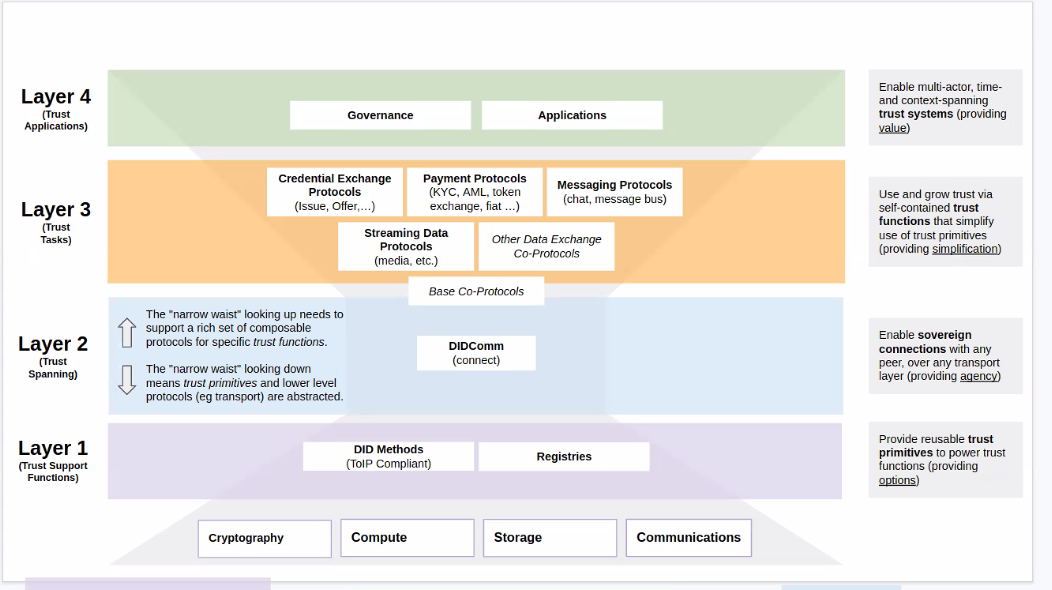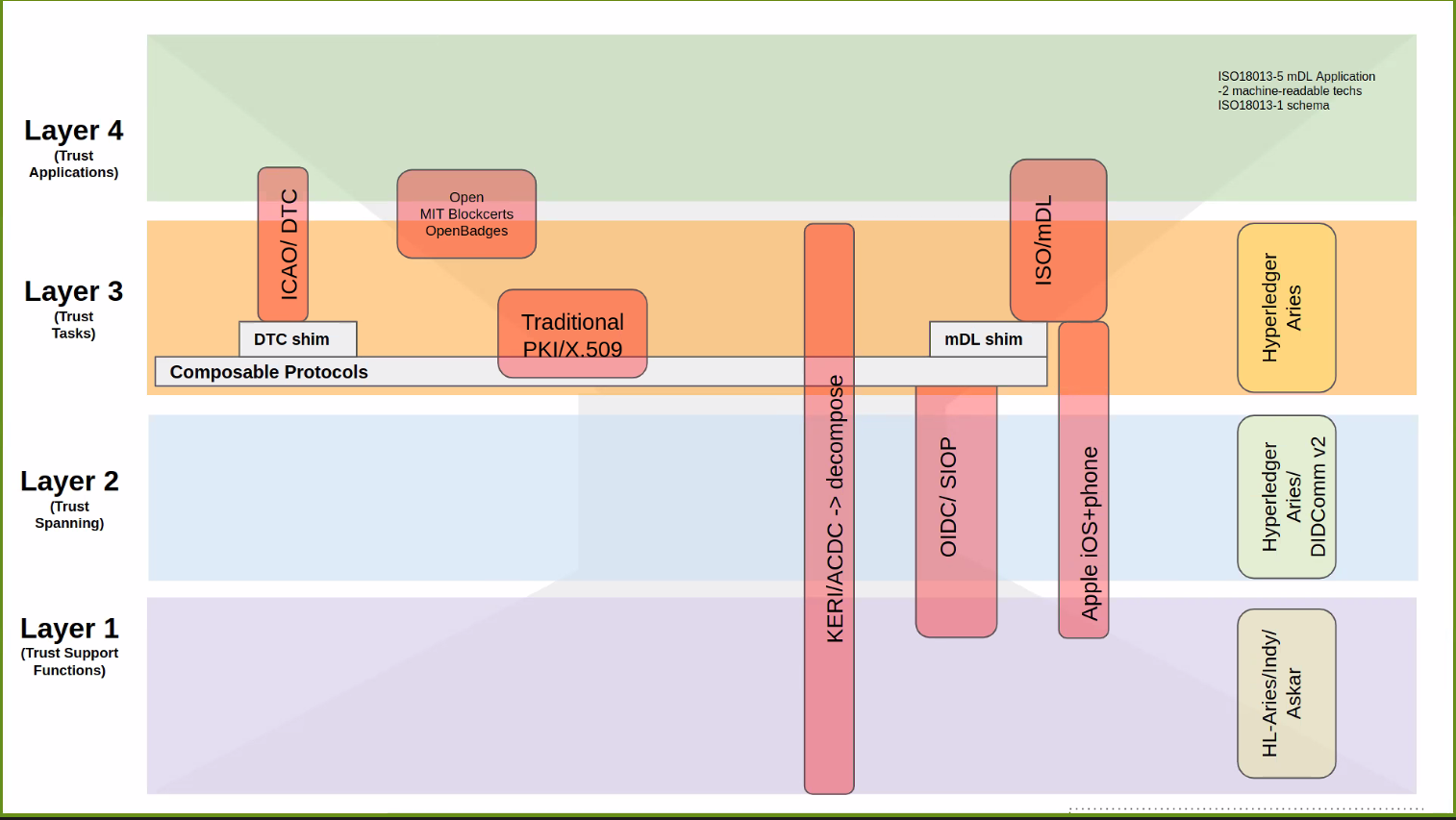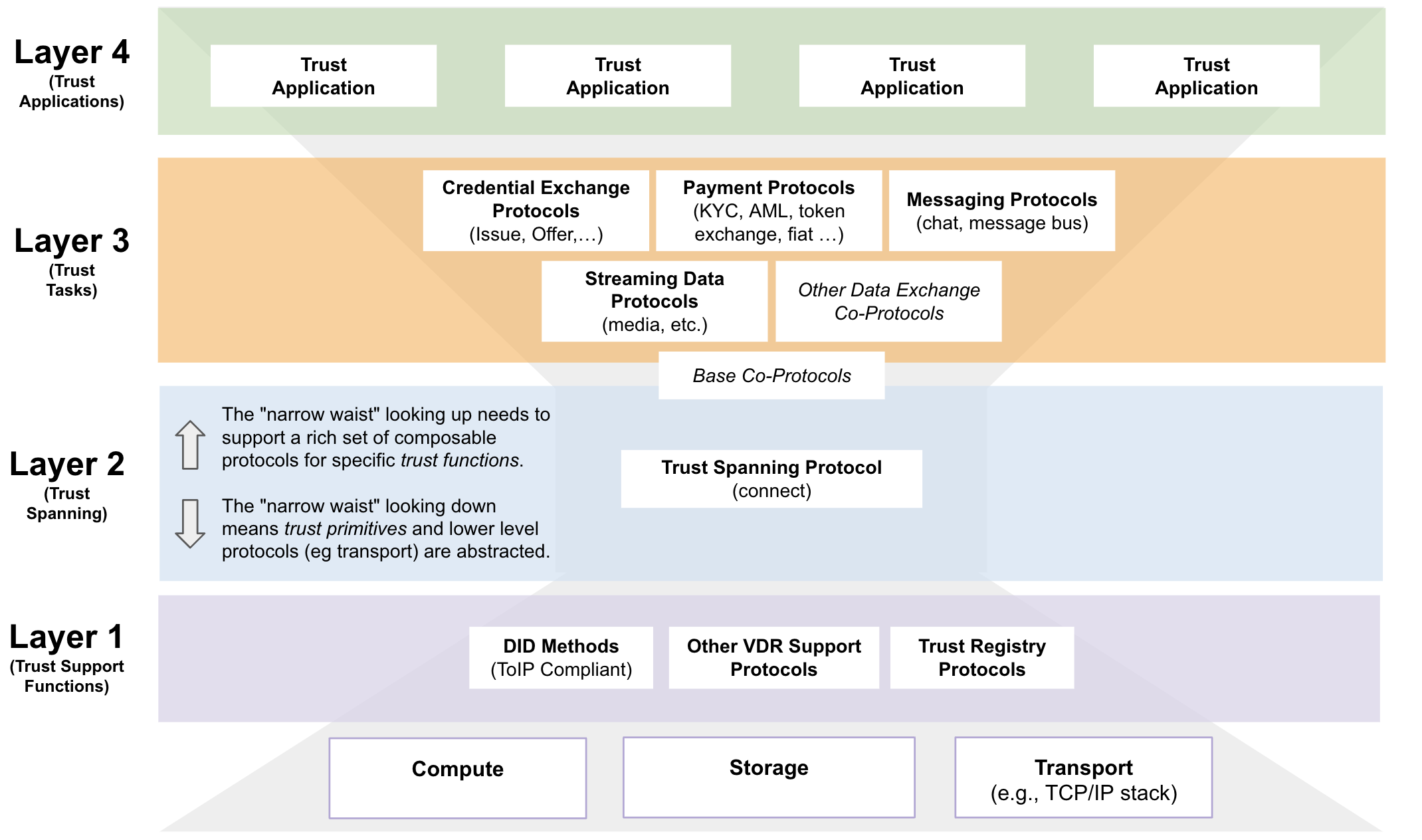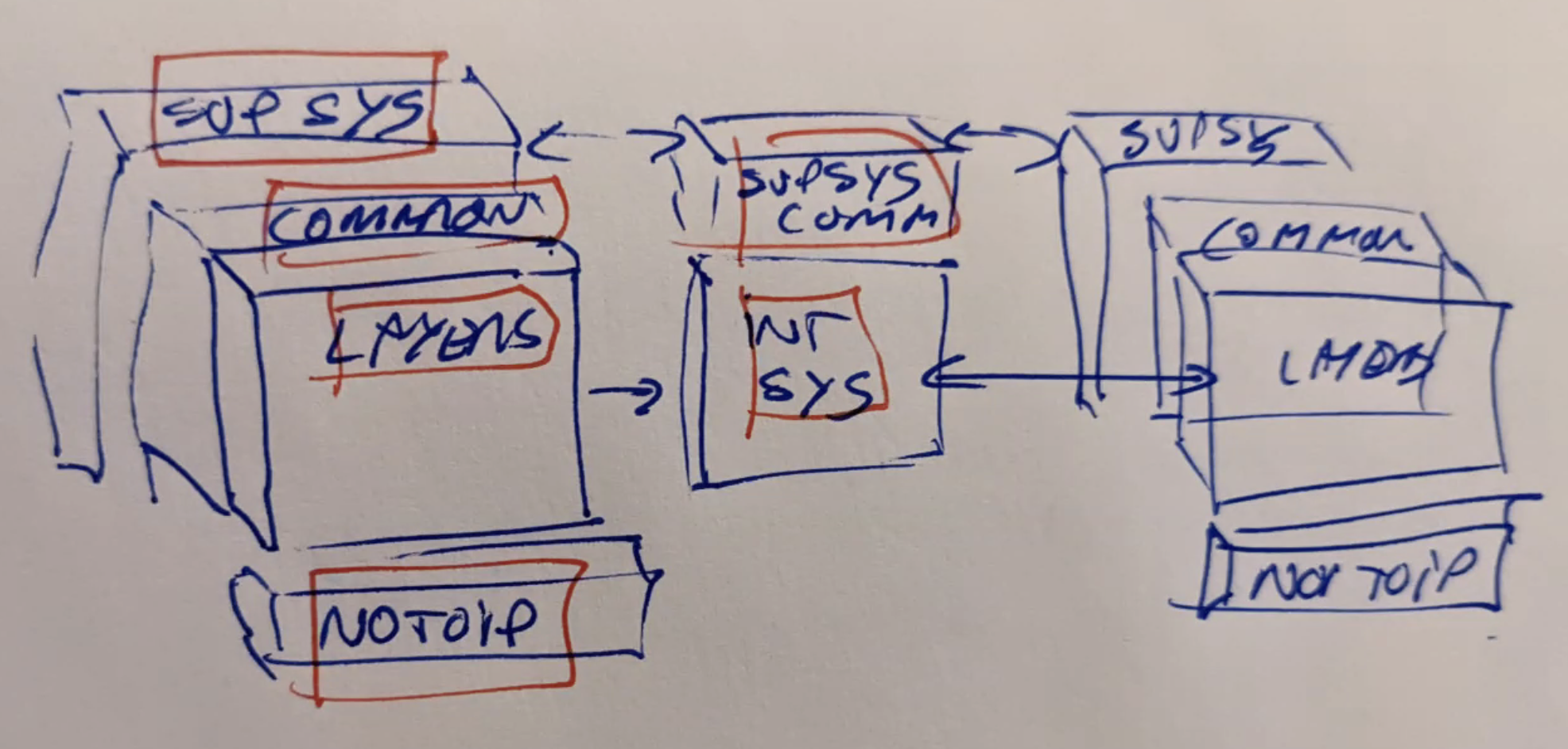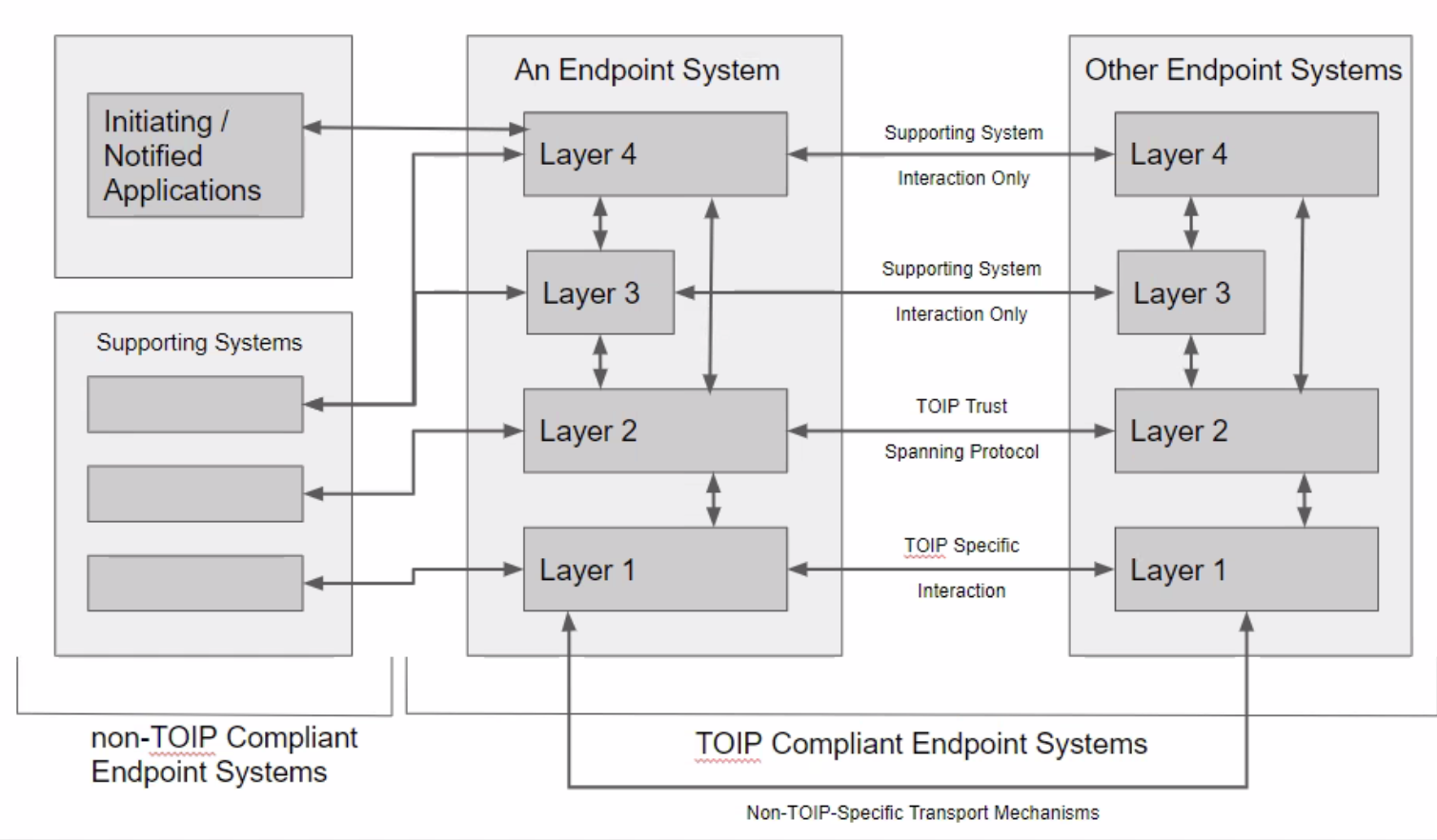Meeting Date & Time
- This Task Force holds TWO meetings weekly every Thursday at the following times (to cover global time zones):
- NA/EU 07:00-8:00 PT / 14:00-15:00 UTC
- APAC 18:00-19:00 PT / 01:00-02:00 UTC
Zoom Meeting Links / Recordings
- NA/EU Meeting: https://zoom.us/rec/share/YfHPCdEJkoZtPfMClJ5Qyl9M2G1I-nDyMShucXjjgJVr4EX24Rw8zCdYRGBFQgTf.bKa2CbiKxDTS-1Cl
- APAC Meeting: https://zoom.us/rec/share/YxiJVlnm8zHTOOC1Qu5Ua1tvAieT7EiGlFdjeL8LrU5E-r_CxY3g9EXYCgahlA.CoSIH3iqKvesevPX
Attendees
NA/EU Meeting
- Drummond Reed
- Darrell O'Donnell <== On vacation
- Wenjing Chu <== On vacation
- Daniel Bachenheimer
- Neil Thomson
- Kevin Dean
- Tim Bouma
- Vikas Malhotra
- Judith Fleenor
APAC Meeting
Main Goals of this Meeting
For the ToIP Technology Architecture Specification: 1) Review additional diagrams proposed by Darrell O'Donnell, 2) Decide about numbering & compiling normative requirements, 3) Review mental model of system types, 4) Next steps for completing the first Public Review Draft.
Agenda Items and Notes (including all relevant links)
| Time | Agenda Item | Lead | Notes |
| 3 min |
| Chairs |
|
| 5 min | Announcements | All | Updates of general interest to TATF members. |
| 2 min | Review of previous action items | Chairs | The notes from the previous meeting (2022-08-03) were not clear about explicit action items.
|
| ToIP Technology Architecture Spec Topics | Discussion of progress on the working draft of the ToIP Technology Architecture Specification: | ||
| 15 mins | Additional diagrams | Drummond Reed | From Darrell O'Donnell in the TSWG Slack channel: I won’t likely make the Thursday meeting. Business has me messing with too much of the time I am supposed to be spending with friends that flew in from out of town.I suggest reviewing the two slides here: https://docs.google.com/presentation/d/1skHbfJqXaX8er8iUzisNWWnFCMp7bv2ZjKmsq4GXyeA/edit#slide=id.gf9dcc57430_0_4
Darrell's first slide is copied as screenshot #1 below and his second slide is screenshot #2. Discussion: First slide could be updated with a vertical side bar that crosses layers for common ToIP support components used by all layers. Scott Perry - need to get more detail. Registries are confusing as they are also needed at layer 4. Replace "registries" with "resolver(s)". Trust spanning is perhaps the right term - suggest interop layer Allan Thomson - need the sidebar for common ToIP components/services. The world hasn't moved to DIDCOMM - what are the preferred protocols and channels for Layer 2. Change this to a set of (Interop) requirements for which DIDComm is the ToIP contribution. Need a diagram version that maps to OIDC (to provide a (conceptual) bridge)
Tim Bouma commented that DIDComm is a "heavy" solution to interop communications. There are several specs that are provided as "full-featured", which may be overkill for initial implementation and acceptance (and actually required functionality). Decentralized identifiers and Verifiable Credentials are other examples. The trend has been to "overspecify". Drummond Reed said it would not only be a mistake to — at this point in time — specify DIDComm as the only Layer 2 trust spanning protocol, not only because there is not yet consensus on that, but because we put specifying explicit protocols out of scope for this architecture spec. That's the job of component specs. ACTION: Drummond Reed to update Darrell O'Donnell's proposed diagram to incorporate the feedback from this meeting and then figure out where it best belongs in the next draft. Neil Thomson suggested we want specifications for each layer expressed as requirements, not solutions and certainly not specific technologies. Drummond Reed agreed with Neil — we need to be designing the right architecture and designing component specifications to meet those requirements. Tim Bouma agreed that it is the need for a trust spanning protocol (or "hourglass protocol") that will "capture the imagination" of readers and help us gain the focus and support we need to complete the work of developing and/or assembling the component specifications. The way he expressed our ultimate goal is: "Today we don't think about how we're communicating (over the Internet); tomorrow we won't have to think about how those communications are trusted." Allan Thomson pointed out that it is not necessarily the purity or beauty of an architecture that wins in adoption of a "stack", but about how easy it is to develop on. He gave a number of examples including TCP/IP. So we need to focus on what is going to use the trust spanning protocol, not the protocol itself. On Darrell's second diagram (screenshot #2 below), there was consensus on the following decision: DECISION: We will add a "Current State Mapping" appendix to the ToIP Technology Architecture Specification whose purpose is to provide a "snapshot" of how existing protocols, APIs, and technologies map into the ToIP technology architecture. ACTION: Drummond Reed to include a first draft of the "Current State Mapping" appendix in the next Working Draft. APAC:
We then talked about the proposed new appendix and how important it was to carry the message about interoperability with existing protocols. |
| 10 mins | Requirements numbering and appendix | Drummond Reed | The notes of the last meeting indicated a discussion of an approach where all normative requirements are numbered throughout the spec and then compiled in a table in an appendix. Darrell O'Donnell and Drummond Reed discussed this when Drummond returned from vacation and before Darrell left on vacation. DECISION: We will number all normative requirements in the ToIP Technology Architecture Specification and compile them into a table in an appendix, including cross-links in both directions. ACTION: Drummond Reed to implement the requirements numbering/compilation decision in the next Working Draft. |
| 10 mins | Mental model of system types | Drummond was on vacation for the last two meetings but saw the notes from the last meeting including the discussion of the mental model of system types. This appeared helpful but still appears to have some issues. Can we close completely on definitions of:
APAC: Jo shared a diagram (no screenshot available) that can help clarify these key terms. Drummond and Neil provided some feedback that Jo incorporated. ACTION: Jo Spencer will move a copy of his slide deck of 3 diagrams to the ToIP Google Drive for the TATF. ACTION: Drummond Reed to incorporate Jo's "systems mental model" diagram and explanation into the next Working Draft. | |
| 10 mins | Next steps on the Working Draft | Drummond Reed | With Darrell O'Donnell and Wenjing Chu both out on vacation this week and next, Drummond proposes to:
|
| 5 mins |
| Chairs |
Screenshots/Diagrams (numbered for reference in notes above)
#1
#2
#3
#4
#5
Decisions
- DECISION: We will number all normative requirements in the ToIP Technology Architecture Specification and compile them into a table in an appendix, including cross-links in both directions.
- DECISION: We will add a "Current State Mapping" appendix to the ToIP Technology Architecture Specification whose purpose is to provide a "snapshot" of how existing protocols, APIs, and technologies map into the ToIP technology architecture.
Action Items
ACTION: Drummond Reed to add the ToIP Google Drive URL to the TATF Meeting Page template.
ACTION: Drummond Reed to implement the requirements numbering/compilation decision in the next Working Draft.
ACTION: Drummond Reed to incorporate Jo's "systems mental model" diagram and explanation into the next Working Draft.
- ACTION: Drummond Reed to include a first draft of the "Current State Mapping" appendix in the next Working Draft.
- ACTION: Drummond Reed to update Darrell O'Donnell's proposed diagram per the feedback in the 2022-08-11 TATF meetings and then figure out where it best belongs in the next draft.
- ACTION: Neil Thomson to create a first draft of a proposed three-dimensional "cube" diagram that can serve as an anchor to tie the different views of the stack.
- ACTION: Drummond Reed to incorporate Neil's diagram into the next Working Draft.
ACTION: Jo Spencer to move a copy of his slide deck of 3 diagrams to the ToIP Google Drive for the TATF.
